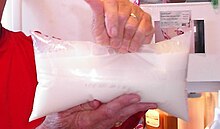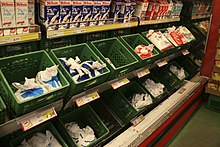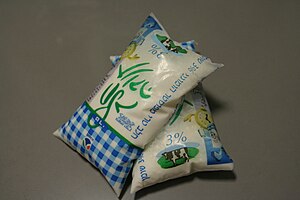

A milk bag is a flexible plastic pouch used to package milk and is used in some areas instead of a hardened milk jug, or as an alternative to it. Usually one of the corners is cut off to allow for pouring, and the bag is stored in a pitcher.
A typical milk bag contains approximately 1 L (1.8 imperial pints) of milk in South America, Iran, Israel, and continental European countries, while in Canada they contain 1+1⁄3 L (2.3 imp pt), and in India, 0.5 L (0.9 imp pt).
In the Baltic rim countries and some Eastern European countries, similar bags may also be seen used for packaging yogurt or kefir.
Benefits
For producers, it is easier to vary portion size when sealing bags than cartons, as well as lowering the cost of packaging. Milk bags also take up less space in the garbage. For consumers, bags typically allow for smaller portion sizes. This theoretically reduces the risk of spoilage, as well as the space and location of storage in the fridge.
Recycling
While milk bags use less plastic than standard plastic bottles or jugs, empty bags are often not accepted for recycling when mixed with other plastics. In Canada, where recycling services are municipally or regionally managed, milk bags may not always be recycled. In some municipalities milk bags are required to be discarded as garbage and in others they are recyclable.
By country and region
This is not an exhaustive list of all the countries where bagged milk is commonly sold.
Canada

In Canada, milk was packaged in heavy, reusable Imperial unit glass milk bottles, cardboard cartons and plastic jugs until 1967, when DuPont, using European equipment, introduced plastic bags to store and sell milk; these bags gained widespread acceptance due to 1970s Metrication in Canada, when bottles, jugs, and cartons had to be redesigned and manufactured in metric units; milk bag packaging machines could easily be resized.
The consumer public preferred plastic jugs for years, but largely accepted the new containers in parts of Ontario, Quebec and the Maritimes in the 1970s. Regulation in Ontario that required retailers to collect a deposit on milk jugs, but not bags, also motivated the practice.
Milk bags are sold in parts of Ontario, Quebec and the Maritimes, but no longer widely sold in western Canada, in Newfoundland and Labrador, or the territories.
India
Milk bags are commonplace in India, with an estimated 30% of milk sold in the country being packaged this way. There has been limited compliance from dairy businesses in buying back consumer plastic as required by the Maharashtra Pollution Control Board.
Israel

In Israel, milk in a bag is the most common type of packaging for milk. They became the standard form of milk packaging in the 1960s, with the discontinuation of glass bottles. In Israel, the milk bag is a regulated product, which means that its price is controlled by the state. Therefore, there are price differences between the milk bags and the other alternatives available for marketing milk — plastic bottles or milk cartons. Due to the price differences, a relationship was observed between the socioeconomic status of the consumer and the type of milk container that they customarily purchased. The higher the socio-economic status of the purchaser, the more likely they are to buy milk in cartons rather than in bags, despite the higher price of cartons. Based on these differences, Blue Square Network created a way to measure the socioeconomic status of an area based on the sales ratio of milk cartons versus bagged milk. The higher the ratio of the former to the latter, the higher the status of the region in Israel. For religious Jews, opening a bag of milk can be considered problematic on Shabbat, because the action requires cutting. Eli Yishai, Israel's former minister of internal affairs, used empty milk bags in the Knesset as props to complain about price-hikes in the cost of milk.
South America

Milk bags are also commonly used in Colombia, Ecuador, Argentina, Bolivia, Brazil, Chile, Paraguay, Peru, and Uruguay.
United Kingdom
In the United Kingdom, Sainsbury's began a pilot experiment on distributing milk in bags in 2008 in conjunction with Dairy Crest. It was originally targeted at 35 stores at the same price as a regular 2-imperial-pint (1.1 L) plastic bottle of milk. The product was expanded nationwide in 2010, at which point the bags retailed at a discounted price compared to traditional containers, but stopped in early 2015.
United States
DuPont introduced milk bags to American schools in 1989; by 1993 three million pouches a day were being served in 24 states. However, the popularity of them waned. There appears to only be one verified school district, in Omaha, NE, using bagged milk as recently as 2015.
See also
References
- Washburn, Devin; Sumar, Sai. "What's up with Bagged Milk?". Lucky Peach. Archived from the original on 1 July 2016. Retrieved 2 August 2016.
- Nosowitz, Dan (2015-10-20). "What's The Point Of Milk That Comes In Plastic Bags?". Modern Farmer. Retrieved 2015-10-22.
- "Can I Recycle Plastic Bags in the Recycling Bin?". Plastics Make it Possible. 2017. Retrieved 2 November 2018.
- "City of Ottawa - Recycling and Garbage - Milk Bags". App06.ottawa.ca. Archived from the original on 2015-05-03. Retrieved 2015-11-02.
- "Recycling List - City of Peterborough" (PDF). peterborough.ca. Archived from the original (PDF) on 2012-03-16. Retrieved 2021-08-17.
- Jackson, Lisa (27 Feb 2017). "Why Do Canadians Drink Bagged Milk?". www.foodnetwork.ca. Archived from the original on 2017-10-12. Retrieved 2021-08-16.
- Gibson, Brittany (2021-07-09). "This Is Why Canadians Drink Milk Out of Bags". Reader's Digest -US. Retrieved 2021-08-16.
- Houck, Brenna (2019-10-21). "Why America's Milk Is Sold in Cartons, Not Bags". Eater. Retrieved 2021-08-16.
- ^ Kelly, Cathal (2010-02-04). "So we drink milk from bags. Does that make us weird?". Toronto Star. Retrieved 2014-01-20.
- Heydari, Anis (January 2, 2020). "Here's why milk comes in bags in parts of Canada". Canadian Broadcasting Corporation.
- Rogers, Thomas. "The future of dairy: Milk in a bag". Salon. Retrieved 28 December 2024.
- Sharma, Shardul. "Pouched milk has revolutionized the Indian milk market". South Asia Packaging. Retrieved 28 December 2024.
- "Plastic ban: Most dairies in Maharashtra yet to start buying back and recycling of milk pouches". Indian Express. Retrieved 28 December 2024.
- Yefet, Orna (8 Dec 2003). "L-2834517,00.html On the relationship between buying milk and socioeconomic status". www.ynet.co.il. Retrieved 1 May 2018.
- "הכנסת: אלי ישי הניף שקית חלב במחאה על ייקור מחירה" [Knesset: Eli Yishai waved a bag of milk in protest of a price increase.]. Ynet (in Hebrew). 2005-01-31. Retrieved 2021-08-16.
- Chertoff, Emily (2012-08-01). "The Surprising History of the Milk Carton". The Atlantic. Retrieved 2015-08-26.
- Blades, Hollye (2008-06-09). "Pinta goes green as supermarkets offer shoppers the chance to buy milk in a bag". The Times. London. Retrieved 16 Aug 2021.
- Neate, Rupert (2008-06-09). "Milk in bags hits Sainsbury's shelves". The Daily Telegraph. London.
- Wallop, Harry (2010-02-24). "Milk in a bag at Sainsbury's". The Daily Telegraph. London. Archived from the original on 2012-11-14.
- "Jug It says it has nationwide success". www.fponthenet.net. Food Processing Magazine. 8 April 2009. Retrieved 2021-08-17.
- "Sainsburys discontinues Milk bags - X / Twitter". Twitter. Retrieved 2023-07-26.
- O'Harrow, Robert (1993-09-11). "SCHOOL MILK CARTONS MAY FACE EXPULSION -US". Washington Post. ISSN 0190-8286. Retrieved 2023-05-12.
- Schools replace milk carton with milk bags, retrieved 2022-09-12
External links
- Canadian Milk Bags Demystified on YouTube—a woman demonstrates the nature of the packaging and how it is readied for use
| Milk | ||
|---|---|---|
| Source |  | |
| Types | ||
| Products | ||
| Containers | ||
| Topics | ||